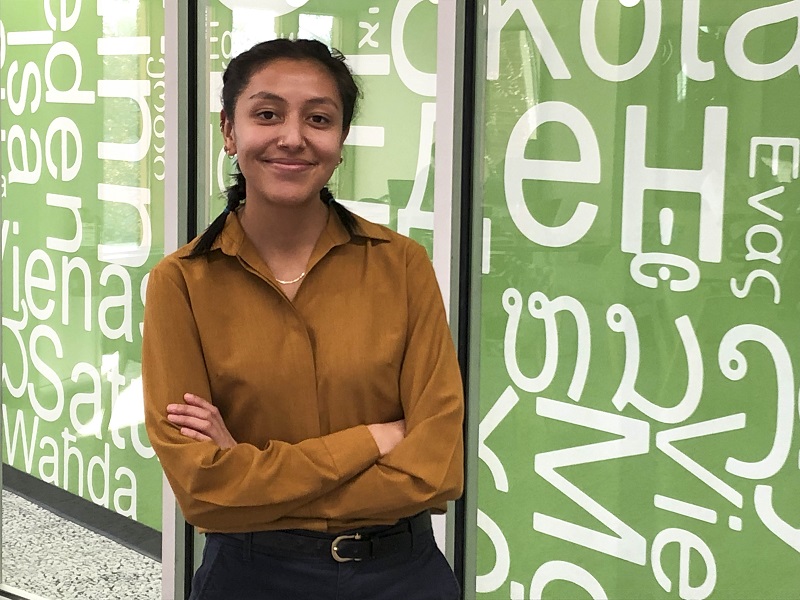University Libraries

Learning Luminary
By Yamilet Perez Aragon
Yamilet Perez Aragon ’23 is spending the 2021-22 academic year as an intern in the University Libraries through the OhioLINK Luminaries program, which offers students paid opportunities in academic libraries to provide a broad introduction to the library and information science profession. Students are paired with mentors to gain knowledge and develop skills for a variety of careers.
During a six-week internship rotation with the University Libraries’ research librarians and library instructors, my biggest task was the development of a program for AVIATE, the University’s residential curriculum and a means of acquiring points for future housing preferences. The program, “Redlining Then & Now: Exploring Long-Term Effects,” followed the Undesign the Redline exhibit in the Stuart & Mimi Rose Gallery. The purpose was to allow students to explore the long-term effects of redlining by examining the historical trends in selected cities using data from the U.S. Census. Our goal was for students to learn how to interpret a historic map from the Home Owners’ Loan Corp. and create a relevant map about a location based on housing and race through the web-based mapping and data visualization tool Social Explorer. They would then generate a report and reflect on the impacts.
Creating an AVIATE session allowed me to think differently about the way I approach presentations. In classes, you have an understanding of your audience’s expertise level because you’ve been learning about the exact same thing, and you can assume they already know some things. For this event, I had no knowledge of what my audience knew, so I had to create a plan that would be useful for different scenarios where the audience either knows a lot about redlining or very little. By asking questions of the audience, I could understand where they stood and how much information I needed to introduce.
I got to learn what it was like to guide others through a process in a way that required verbal instructions, visual examples and walk-throughs on the screen. I had to remember that the students were encountering this website for the first time, whereas I already had familiarity with it because I’d navigated and researched it. Another important lesson I learned was how to be as clear as possible when teaching. Even when Heidi Gauder, my mentor, broke down instructions clearly and simply, students still got lost or had a hard time understanding, so I learned that it is important to go slowly, be clear and make sure everyone is following along step by step. That is something I will take with me going forward.
Instruction sessions
The importance of good instructions became even clearer when I assisted in instruction sessions led by Professor Gauder and my other mentor, Zachary Lewis, an assistant professor and student success librarian. Professor Gauder offered the students small origami booklets to take notes on. I learned that it’s important for students to have the tools they need to retain information. I also learned that it helps to ask questions every once in a while when you are teaching because if you just keep talking, students might daydream or start zoning out. When Professor Gauder asked them to share or call out experiences of what they knew, students stayed engaged and alert. During Professor Lewis’ session, I really liked the clear transitions between the steps in his lesson plan. This made it easier for students to keep up and know what stage they were in at every moment. This inspired me to plan clear transitions when I organized my own event.
Interviewing librarians
Interviewing librarians was the most interesting part of this rotation. I learned about such different topics and places, which made it feel as though I was interviewing people from different fields. When I was learning about the librarians’ educational background, I thought it was interesting that the schools were all over the country. I was also surprised at some of the tracks and majors some had — from biology to English to computer science to arts. The most surprising thing was just learning about their very different paths to the UD Libraries. It reassured me that you can try different things at different points in your life, and you don’t have to have one job for the rest of your life. It can take time, and you can try out many routes.
I also learned that what it means to be a librarian can vary across universities, cities, states and countries. From the experiences they shared, I saw that the structure of libraries differs a lot from one place to the next. The requirements, responsibilities and expectations can vary, especially between government and higher education. Something I noticed among all of the librarians I interviewed was that the people they work with are a big factor in what they like about working at UD. It seems like everyone likes the collaborative side of librarianship because they have trust and camaraderie with the people around them.
One thing I asked every single person was, “What is something you wish more people knew about libraries?” The most common answer was that people miss out on so many resources because they’re not aware of them. The librarians really wanted to emphasize that research is expensive, and the University Libraries offer access to a lot of information that people outside UD can’t get without paying a lot for it.
